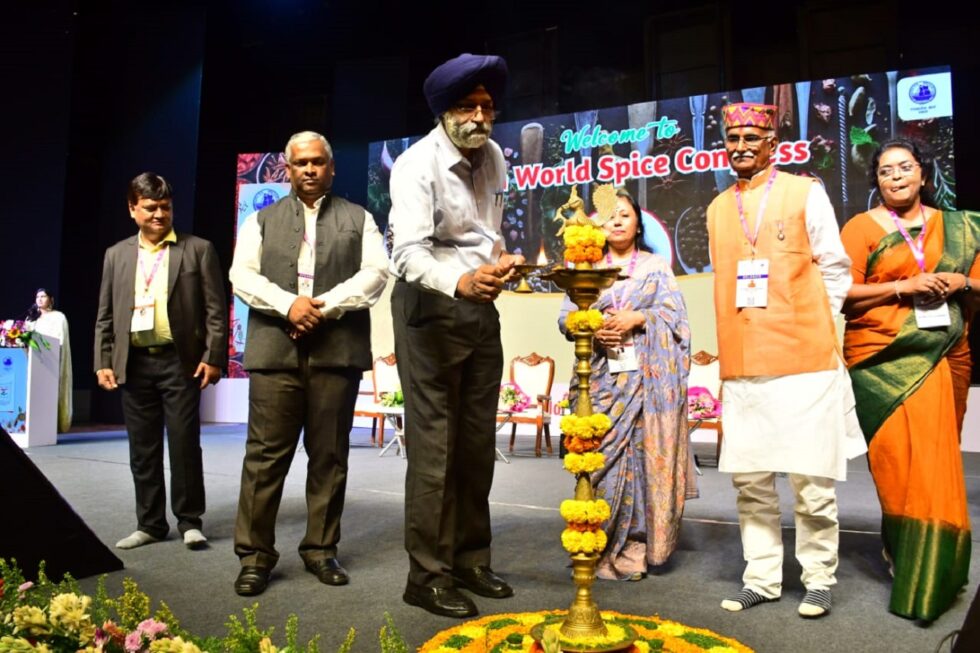
NAVI MUMBAI:
The mega spice event, the 14th World Spice Congress commenced today. Amardeep Singh Bhatia, Additional Secretary, Dept. of Commerce, Government of India, during his inaugural address for the 14th edition of the World Spice Congress said that India’s spice export is $4 billion and is expected to reach $10 billion by 2030.
“India is a leading player in the global spice industry. Traditionally India has been spices centre of the world. In order to ensure that India continues to maintain its traditional strength there are several things to work on in the entire chain of spices from growers to marketers,” he added. “It is a shared responsibility of the government and Spices Board to come up with schemes and programmes to facilitate testing labs, assessment quality standards, etc. This three-day event will give lot of business opportunities to all the stakeholders, delegates, exhibitors and producers,” he said.
Highlighting the potentials of the Indian spices industry, D Sathiyan, Secretary, Spices Board, said, “The spices legacy is part of human culture. India is the spice bowl of the world. There is tremendous potential to explore product development, biotech, etc. in India. More than 75 spices are grown in India and each state has spices to offer. The future of the world spice industry will be discussed at the three-day event of World Spice Congress.”
The first day of the event commenced with the inauguration of exhibition highlighting the variety of spices and value-added spice products as well as innovative technologies and solutions in the spices industry and a visual presentation on Indian Spice Sector by Mr. D Sathiyan, Secretary, Spices Board. While presenting he highlighted the illustrious journey of the Indian Spice industry, current trends, emphasizing technology, sustainability, and the demand for unique blends. With an eye on the future, he ignited optimism for the industry’s boundless growth potential in an increasingly diverse world.
The event was followed by the technical session on Country perspective of the Spice Industry and Global opportunities. The session was chaired by Dr. Sanjay Dave, Former Chairperson of the Codex Alimentarius Commission and Former Advisor, FSSAI and co-chaired by Sanjeev Bisht, Chairman, AISEF. Sudhakar Vardhan Singh Tomar, President, India Middle East Agri Alliance, UAE, Agus P. Saptono, Senior Officer, Directorate General of Asia Pacific, Ministry of Foreign Affairs, Indonesia, Mohammad Javad Hosseini, Deputy Chief of Mission at the Embassy of I.R of Iran in India, were the esteemed speakers for the session. During the session it was discussed how opportunities exist for spice-producing countries to expand their exports, focusing on quality, sustainability, and traceability to meet international standards.
The second session on Evolving market requirements for spices trade was focused on the adaptation to global supply chain resilience, market research, and consumer insights is vital, making agility and responsiveness are crucial for success in this evolving spice market. The session was chaired by Smita Sirohi, Joint Secretary, Ministry of Agriculture and Farmers Welfare, Government of India, and co-chaired by Dr M R Sudharsan, Chairperson, CCSCH. Speakers, Dr. Sarah McMullen, Country Director-USFDA in India, Dr. Mwate Mulenga, Counsellor Agriculture & Technical Specialist, High Commission of Canada in India and Mr. Fakhri Aliyev, First Secretary, Embassy of Azerbaijan in India shared their insights.
The theme for WSC 2023 is “VISION 2030: Sustainability, Productivity, Innovation, Collaboration, Excellence, and Safety” (S.P.I.C.E.S). The sessions will address crops and market forecasts and trends; food safety and quality standards and certifications; trends and opportunities for spices in pharmaceutical, nutraceutical, innovative and preventive health care products; spice-based seasonings and functional food products; ready-to-use/cook/ drink products; trends and opportunities for spice oils and oleoresins, consumer preferences and emerging trends; reliability and integrity in supply chain management, international requirements on packaging, trends and opportunities in global spice markets, etc.




